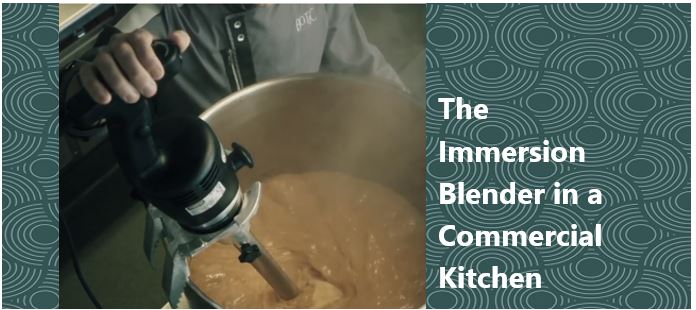If you’re looking for a kitchen appliance that provides you with great flexibility and functionality, the immersion blender or stick blender is a great choice. It is considered one of the most versatile pieces of food prep equipment by many professional chefs and commercial cooks alike. An immersion blender can be used just as a standard blender, but because the immersion blender is the blade only with a protective housing, it can be used to mix product pots, bowls, kettles, tilt skillets or where ever needed.
An important consideration, when shopping for an immersion blender includes what you will be blending as well as where you expect to be using your blender. If you anticipate using it in a kettle, then you’ll want to be sure that you have a larger model, not just for the power, but for the length. The shaft for most stick blenders varies from 12 to 22 inches in length. You will find immersion blenders in light, medium and heavy-duty models. Most of the light-duty blenders, which are also typically the smallest size, are not used in commercial kitchens because they simply aren’t powerful enough to get through the larger batches and higher volumes of product. They may however be appropriate for a coffee shop where an immersion blender could be used for blending individual servings, frothing or foaming and creating blended desserts. However, larger immersion blenders, often NSF-approved, are a better fit for the busy commercial or institutional kitchen. These heavy-duty immersion blenders with longer shaft and larger motors can be used for blending thicker foods like hearty blended soups or pureed vegetables, even dense foods like refried beans. These larger units may also require pan support due to their weight. But with a attachment that holds your immersion blender in place, the task of blending a split pea soup in a 60 quart stock pot is simplified and does not require a person to hold the immersion blender.
Along with having the right size blender, you need to have the sufficient horse power for the blender motor to complete any specific heavy menu offerings. Commercial immersion blenders start aw ½ HP and go up to 1 HP with some of the heaviest duty units requiring 2 handed operation. The motor power provides the torque needed to power blenders with longer shafts and to manage the vortex flow of product around the blades. Thicker foods require the blending unit to have longer blades within a larger bell housing.
Because commercial immersion blenders are relatively simple in design consisting of a motor casing of stainless steel, the bell which includes the blades and tube or shaft, there are minimal standard features. In some units, you may find that the bell and the blade can be removed for easier cleaning. You will find units with a single speed or variable speed operation. Nearly all are electric and 11 volt is common. Some models will be cordless. For attachments, you will find immersion blenders that offer a blending arm, whisk attachments usually varying between 7” to 10” in length, bowl clamps for attaching to a large pot or kettle during mixing, an extra handle may be available to provide better grip or leverage during operation, and a carrying case. For the larger immersion blenders, you may find that a mounting rack providing out of the way storage is available.
Cook’s carries a wide variety of commercial immersion blenders including Waring, Hamilton Beach, Robot Coupe, and KitchenAid.


















